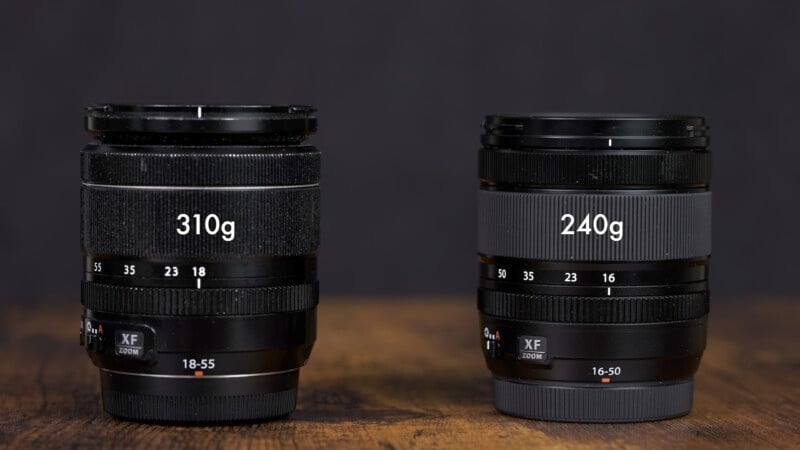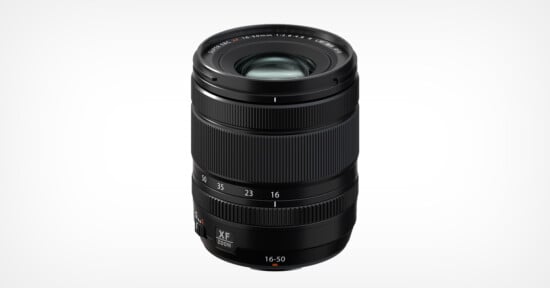Fujifilm XF 16-50mm f/2.8-4.8 Review: A Lot To Live Up To
The Fujifilm XF 18-55mm f/2.8-4 R LM OIS was truly a legendary kit lens. It broke the stereotype of bare-bones kit lenses that came packaged with slow apertures and pedestrian optics. I say was because it now must make way for a new lens to take center stage. The new Fujifilm XF 16-50mm f/2.8-4.8 has very big shoes to fill indeed.

Fujifilm XF 16-50mm f/2.8-4.8 Review: How it Handles
The first thing that I noticed about the new $699 lens was its lightweight design and internal zoom. There is no further extension of the lens while zooming and it weighs less than the 18-55mm at only 8.46 ounces (246 grams). It has the same 58mm filter diameter and also carries the WR badge to signify its full weather-sealed build.

The linear autofocusing motors ensure snappy operation even in fast action situations and everything feels tight and sound. The 16-50mm has a familiar look and a similar manual focus ring, zoom throw, and aperture ring design to its predecessor. Like some other Fujifilm lenses, there is no need for an AF/MF selector switch as this is handled with a separate switch on most of the bodies and there is also no OIS control switch because the 16-50mm does not feature image stabilization.

Fujifilm XF 16-50mm f/2.8-4.8 Review: How it Shoots
The choice to leave out a lens-based image stabilizer may initially seem like folly. However, it does allow the lens to be lighter and smaller while at the same time relying on the excellent IBIS stabilization built into most of the modern Fujifilm bodies. Certainly, anyone using an older body or an entry-level body will feel understandably shorted but for any cameras in the future, or even the brand new X-T50 which now also incorporates IBIS, the loss won’t sting as much.

A kit lens has to be versatile to allow a beginner user to explore as much photography as possible before seeing where they need to upgrade or supplement their kit. To that end, the 16-50mm has an excellent macro capability for a general-purpose lens. The minimum focusing distance is 24cm from the focusing plane which at 16mm does not deliver a very impressive macro magnification. It’s a different story at 50mm though where the working distance from the lens front to the subject is acceptable and the 0.3X magnification gives its owner the ability to shoot fun close-ups with plenty of detail.

Flare is fairly well-controlled with a little bit of ghosting present whether shooting wide-open or at stopped-down apertures. Contrast is well retained even with bright light sources directly in the frame and I think most people will find the results acceptable. Sunstars unfortunately lack any sort of clarity or drama which is to be expected out of a more mainstream lens design.

Bokeh was also fair-to-middling with some cat’s eye present at wider apertures and a strong soap bubble look to the specular highlights. The bokeh also shows distinct onion rings in the highlights. All of these understandably weird terms come together to mean that the general look of the soft background or foreground areas tends to have a more frenetic and distracting look to it. Keep in mind that this would be in comparison to an expensive, professional lens which would generally have soft and smooth transitions to the out-of-focus areas. Also, remember that this lens, with its slower f/4.8 aperture, doesn’t make images with an extremely shallow depth-of-field anyway which helps to mitigate the issue.

Fujifilm XF 16-50mm f/2.8-4.8 Review: Sharpness is Key
Sharpness is really at the heart of why we have a new 16-50mm kit lens to be paired with a new Fujifilm body. With many of the newer bodies now featuring a 40-megapixel sensor, the older 18-55mm was starting to show its age. It just can’t quite fully resolve enough detail to make good use of the 40-megapixels, especially at wider apertures. The new 16-50mm primarily has been designed to give the extra resolving power that the latest bodies need.

At 16mm, sharpness in the center is excellent at f/2.8 with no real need to stop down for more image quality. Corners tends to look a little soft at f/2.8 but sharpen up nicely at f/5.6. At the 50mm range, I’d say detail is ever-so-slightly less than at 16mm but the results are still good for the new sensors. Center sharpness is decent at f/4.8 and there is some noticeable improvement at f/5.6. Corners at 50mm are more consistent than at the wide end and look pretty good at f/4.8 with some further benefit just stopping down slightly to f/5.6.
Overall, the lens fulfills its purpose to deliver appropriate detail where the older 18-55mm simply cannot.


The Fujifilm XF 16-50mm f/2.8-4.8 Has a Lot to Live Up To
The performance of the new 16-50mm is admittedly a bit mixed. There are some compromises, such as the slower f/4.8 aperture at the telephoto end, which isn’t ideal, and the lack of OIS, which may or may not impact you, is still worth pointing out. That said, I like the new size and weight and the sharpness is definitively much better which makes the 16-50mm a good option if you are buying a new 40-megapixel body. Somehow I don’t imagine that this new lens will inspire the same cult status that the older 18-55mm will, but I do think it will be seen as a respectable workhorse lens going forward.

Alternatives?
The older (and identically priced) 18-55mm f/2.8-4 still provides a good amount of light and decent sharpness for sub 26-megapixel bodies so get them while you still can. The Sigma 18-50mm f/2.8 is also appealing for its fast aperture and decent sharpness and the price is a very reasonable $550.
Should You Buy It?
Maybe. That answer depends largely on whether you are purchasing a 40-megapixel body and can get the new lens at a kit price with said camera. It’s also a decent option if you want to future-proof your kit if and when you upgrade to a higher-megapixel camera.



